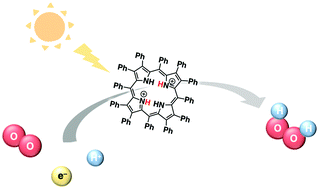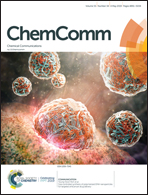Efficient photocatalytic proton-coupled electron-transfer reduction of O2 using a saddle-distorted porphyrin as a photocatalyst†
Abstract
Photocatalytic O2 reduction reactions proceeded to produce H2O2 using a diprotonated saddle-distorted dodecaphenylporphyrin as a photocatalyst. The quantum yield (12%), the turnover number (3000 for 6 h), and the turnover frequency (500 h−1) are achieved in photocatalytic systems based on free-base porphyrins for the first time. The photocatalytic reaction mechanism has been revealed by ns-laser flash photolysis and kinetic analysis.

- This article is part of the themed collection: Frontiers in Proton Coupled Electron Transfer (PCET)


 Please wait while we load your content...
Please wait while we load your content...